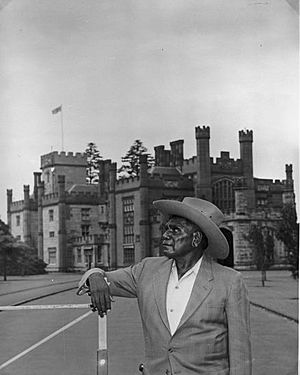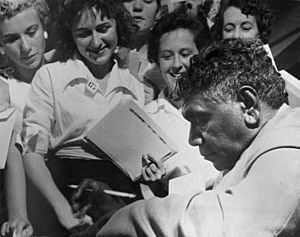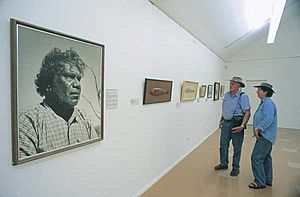Albert Namatjira facts for kids
Quick facts for kids
Albert Namatjira
|
|
|---|---|

Namatjira, c. 1950
|
|
| Born |
Elea Namatjira
28 July 1902 |
| Died | 8 August 1959 (aged 57) Alice Springs, Northern Territory, Australia
|
| Nationality | Australian |
| Known for | Watercolour painting, contemporary Indigenous Australian art |
| Spouse(s) | Rubina |
| Awards | Queen's Coronation Medal |
Albert Namatjira (born Elea Namatjira; 28 July 1902 – 8 August 1959) was a famous Aboriginal artist from Central Australia. He was a pioneer of contemporary Indigenous Australian art, meaning he was one of the first to create modern Aboriginal art. He became the most well-known Indigenous Australian of his time.
Albert Namatjira was a member of the Western Arrernte people. He was born and grew up at the Hermannsburg Lutheran Mission near Alice Springs. He loved art from a young age. In 1934, when he was 32, he started painting seriously with help from Rex Battarbee.
Namatjira's detailed watercolour paintings showed the Australian outback. His style was different from traditional Aboriginal art, which often used abstract designs. His work inspired the Hermannsburg School of painting. He became very famous in Australia, and copies of his paintings were in many homes.
He was the first important Aboriginal artist to paint in a Western style. At first, people thought his art showed that Aboriginal people were fitting into Western society. However, later on, people realised his work also included many parts of traditional Aboriginal culture and art.
In 1957, Albert Namatjira was the first Aboriginal person in the Northern Territory to get special rights. He was given limited Australian citizenship, which meant he could vote and own some land. In 1956, a painting of him by William Dargie won the Archibald Prize. This was the first time a portrait of an Aboriginal person won this award. Namatjira also received the Queen Elizabeth II Coronation Medal in 1953. Australia honoured him with a postage stamp in 1968.
Contents
Early Life of Albert Namatjira
Albert Namatjira was born as Elea Namatjira in 1902 at the Hermannsburg Lutheran Mission near Alice Springs. His parents were Namatjira and Ljukuta, who were Western Arrernte people.
He grew up at the Hermannsburg Mission. His parents became Christians, and he was baptised and given the name Albert. As a child, he loved to sketch what he saw around him. He went to school at the mission and lived in a dormitory, separate from his parents. When he was 13, he went back to the bush for a special ceremony. This helped him learn about traditional culture and become a member of the Arrernte community. He later became an elder.
When he was 18, he left the mission and married Ilkalita, a Kukatja woman. She was later christened Rubina when they returned to Hermannsburg. They had five sons and three daughters.
His marriage was against the rules of his people's kinship system. Because of this, he was excluded from his community for several years. During this time, he worked as a camel driver. This job allowed him to travel and see much of Central Australia, which he later painted. He also worked as a blacksmith, carpenter, and stockman on the mission and nearby cattle stations.
Albert Namatjira's Art Career
Albert Namatjira learned about Western-style painting from an art show at his mission in 1934. Two painters from Melbourne, Rex Battarbee and John Gardner, held the exhibition. Battarbee came back in 1936 to paint the landscape. Namatjira wanted to learn, so he became Battarbee's guide and helped him find beautiful places to paint. Battarbee taught him how to use watercolours.
Namatjira developed his own unique painting style. His landscapes often showed the rough mountains in the background. In the front, he painted special Australian plants, like old, grand white gum trees surrounded by twisted bushes. His paintings were very bright, showing the deep cuts in the land and the twists of the trees. He used colours similar to the ochres his ancestors used to paint the same land. Europeans liked his style because it fit with Western art ideas.
Early in his career, Namatjira also painted sacred designs and biblical scenes. He also carved and painted different objects.
In 1937, ten of Namatjira's watercolours were shown at a conference in Nuriootpa, South Australia. Battarbee also put three of his paintings in an exhibition in Adelaide. In 1938, Namatjira had his first art show in Melbourne, which was a big success.
He became the first well-known Aboriginal artist to paint in a modern Western style. Because of this, he was seen as an example of cultural assimilation, where people from one culture adopt the ways of another. In 1944, he was even included in Who's Who in Australia, a book about important Australians.
Later art shows in Sydney and Adelaide also sold out quickly. His art became very popular in Australia and other countries. Queen Elizabeth II was one of his fans. He received the Queen Elizabeth II Coronation Medal in 1953 and met her in Canberra in 1954. In 1955, he became an honorary member of the Royal Art Society of New South Wales.
Not only was his own art famous, but a painting of him by William Dargie won the Archibald Prize in 1956. This was the first time a portrait of an Aboriginal person won this important award.
Later Life and Challenges


Because he earned a lot of money, Namatjira faced a challenge known as "humbugging." This is a traditional Aboriginal practice where people are expected to share everything they own. As Namatjira's income grew, so did the number of his relatives who needed support. At one point, he was financially supporting over 600 people.
To help his large family, Namatjira tried to lease a cattle station. This was first approved but then rejected. He also tried to build a house in Alice Springs but was tricked and sold land that was not suitable for building. The government offered him free land in a reserve, but he refused. Namatjira and his family ended up living in a poor camp outside Alice Springs. Even though he was one of Australia's greatest artists, he was living in poverty. The media reported his situation, causing public anger.
In 1957, the government made a special rule for Namatjira and his wife. They were freed from the strict laws that applied to most Aboriginal people in the Northern Territory. He was given a limited form of Australian citizenship. At 55 years old, Albert Namatjira became an Australian citizen. This allowed him to vote, own land, and build a house. However, his adult children and other relatives were still considered "wards," meaning they were under government control. This special status was given to him, even though he didn't ask for it.
His Last Years
Namatjira continued to live with Rubina in a small house at Papunya. There, he had a heart attack. He was moved to Alice Springs hospital. Before he died, he gave his mentor, Rex Battarbee, three new landscape paintings. He promised more, but he passed away soon after. Albert Namatjira died on 8 August 1959 in Alice Springs from heart disease and pneumonia.
Albert Namatjira's Legacy
By the time he died, Albert Namatjira had painted about two thousand pictures. Today, he is seen as one of Australia's greatest artists. He is also remembered as a pioneer for Aboriginal rights. Many of Namatjira's paintings are shown in major art galleries across Australia. The Art Gallery of New South Wales now has many of his works.
Several films have been made about Namatjira's life, including a 1947 documentary called Namatjira the Painter.
Before he died, part of Namatjira's copyright (the legal right to his art) was sold. After his death, his copyright was sold again in 1983 for a small amount of money, even though his will said it should go to his family. In 2017, the copyright was finally returned to his family's Albert Namatjira Trust. This happened thanks to a donation from a generous person named Dick Smith.
Many songs have been written about Namatjira. Country music star Slim Dusty recorded a tribute song called "Namatjira" in the 1960s. Other songs include "Raining on the Rock" by John Williamson and "Albert Namatjira" by the band Not Drowning, Waving. He is also mentioned in the famous patriotic song "I Am Australian".
Namatjira has been honoured on postage stamps by Australia Post several times: in 1968, in 1993 with examples of his work, and in 2002 for his centenary.
The Namatjira Project started in 2009. It included a theatre show by Big hART that won awards. The show focused on Namatjira's life and art.
In 2012, an area in the Northern Territory near Alice Springs was renamed the electoral division of Namatjira in his honour.
In January 2013, two gum trees that appeared in many of Namatjira's paintings were destroyed in a fire. This was called a "tragic act of cultural vandalism." In 2015, people tried again to have the "Twin Gums" site protected as a heritage site.
Many of Albert Namatjira's descendants are also artists. They paint at the Iltja Ntjarra - Many Hands art centre in Alice Springs.
On 28 July 2017, Google celebrated Namatjira's 115th birthday with a special Google Doodle for Australian users. This showed how much he contributed to Australian art and culture.
Vincent Namatjira, Albert Namatjira's great-grandson, is also a well-known artist. He won the $100,000 Ramsay Art Prize in 2019. Vincent's 2014 art series, Albert's Story, tells about Albert Namatjira's life and his lasting impact. Vincent said, "I hope my grandfather would be quite proud, maybe smiling down on me; because I won’t let him go. I just keep carrying him on, his name and our families' stories." Vincent's work was also chosen as a finalist for the Archibald Prize in 2017, 2018, and 2019. He won the prize in 2020.
See Also
 In Spanish: Albert Namatjira para niños
In Spanish: Albert Namatjira para niños



